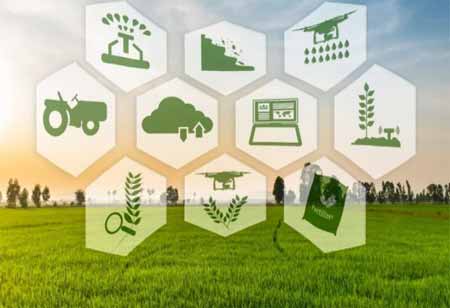Thank you for Subscribing to Agri Business Review Weekly Brief
Top 9 Agtech Solutions Changing the Future of Agriculture Sector
It is great to know that the deployment of smart farming is growing gradually, but how precisely it will benefit farms is outlined here.

By
Agri Business Review | Wednesday, June 23, 2021
Stay ahead of the industry with exclusive feature stories on the top companies, expert insights and the latest news delivered straight to your inbox. Subscribe today.
It is great to know that the deployment of smart farming is growing gradually, but how precisely it will benefit farms is outlined here.
FERMONT, CA: Farming technology transforms the agricultural industry's operational procedures and expectations with the available heavy dose of innovations and disruption. Like any other tech-transformed sector, the farm space needs to cope with the evolving working styles, equipment updates, and the demand for quick outcomes. However, unlike other sectors, agriculture also has to contend with using such technology to radically transform how food is manufactured, sustain the population, and save the environment. Agriculture digitalization is based on the growth and implementation of new manufacturing tools and machines. As a result, the coming agricultural revolution would be green, with science and technology at its heart. Here are a few techniques that drive the methods of smart farming.
Automation
The significant change in agricultural manufacturing is the increasing role of automation technology, which improves productivity by decreasing the need for human labor. This can take several forms, from automated cars to developing task-specific robots that automate manufacturing process components.
Hydroponics
Hydroponics is a hydroculture that uses mineral nutrient alternatives in a water solvent to grow crops without soil. Along with enhanced revenues from enhanced returns, the market is anticipated to be driven by the growing demand for salad plants and the increasing need for global food security. As reported by Research and Markets, by 2020, the market value of hydroponics is expected to expand by $27.33 billion.
3D- Printing Technology
3D printing technology will be critical to how individuals communicate with food in the future. Supermarkets are already testing customized cakes to 3D print, caterers/restaurants offer printed desserts. Some even argue that every home will quickly have a 3D food printer. It is estimated that the market for 3D-printed food will reach $425 million by 2025. This is a niche and innovative method; companies are unlikely to transform product lines into printing, but it provides food companies the chance to study the customization of their mass-produced, commoditized products.
Precision Farming
Precision farming, or precision farming, is an umbrella concept for IoT-based methods that enhances the control and accuracy of agriculture. So, crops and cattle receive the therapy they need, determined by superhuman precision machines. Farmers can increase the efficiency of pesticides and fertilizers or use them selectively by accurately evaluating differences in a field. Methods of precision farming use machine learning techniques and the Internet of Things –will optimize soil and water use for various crops and farming circumstances, reduce expenses and increase output while decreasing freshwater use. Applying big data analytics to insurance stats on farming circumstances and returns will reduce the hazards to farmers trying fresh plants and farming techniques.
3D Ocean Farming: A Vertical Approach to Aquaculture
3D ocean farming consists of horizontal ropes on the water's surface, attached to hurricane-proof floats, connecting underwater lines supporting seaweed plants, and interspersed with hanging net enclosures to grow scallops and molds. Also linked to the ground, ropes, clam, and oyster cages sit on the seafloor. From the coast, this type of farm is scarcely noticeable. The farm also offers important non-edible advantages: it acts as a protector for storm-surge and as a habitat for marine wildlife.
Agricultural Drones
Agriculture is one of the main verticals incorporating ground and aerial drones for crop health assessment, irrigation, crop tracking, crop spraying, planting, soil and field evaluation, and other areas. Since drones collect multispectral, thermal, and visual imagery while flying, their data provides farmers insight into a broad spectrum of metrics such as crop health indexes, plant counting, yield prediction, plant height measurement, survey reports, stockpile measurement, and drainage mapping.
Telemetry
With growers facing water scarcity owing to drought, aquifer depletion, and water allocations, innovations in irrigation techniques are becoming even more essential. Telemetry is one latest progress. Products now enable growers to remotely monitor and regulate almost every facet of their irrigation operation. The systems are saving on cars, water, time, fuel, and wear and tear. Soil moisture monitoring, weather data, and Variable-Rate-Irrigation (VRI) will be integrated into their systems by producers in the future.
Robotics: Connected tractors
The tractor and implementation are important tools for the agricultural industry's growth. These agrarian instruments are optimized by connectivity and localization techniques (GPS). This involves help from drivers in optimizing paths and shortening harvesting and crop treatment while decreasing energy consumption. In addition, sensors' tight surveillance and control of crop treatments enable significant effectiveness and productivity gains.
Check Out This : METALS & MINING Review
Check Out This : CIOReview EUROPE
IoT
The capacity of IoT technologies to cope with and communicate with legacy technology is another important necessity of the agricultural industry. Although most of the farming equipment sold today incorporates digital capacities, most of the fleet continues pre-digital tractors, tools, and machines that will take a long time to replace. As a result, agricultural technology's lifespan mainly outplays communication technologies' lifespan.
Based on a more accurate and resource-efficient strategy, smart farming enhanced by these techniques has a real opportunity to achieve a more productive and sustainable agricultural output.





